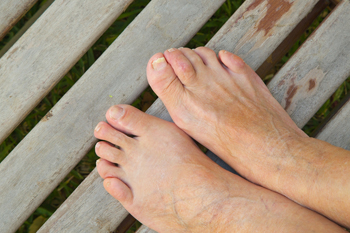 Ingrown toenails can occur in two different ways. Either the edge of the toenail grows into the skin, or the skin grows over the toenail. Signs of ingrown toenails may include swelling and redness on the sides of the toenail, and if infected, pus may drain from the area as well. Ingrown toenails can be caused due to a variety of factors that can include tightly-fitted shoes, thickened toenails, hereditary factors, and abnormally shaped toenails. While experiencing an ingrown toenail may be painful, there are many solutions to help relieve the pain. This can include wearing properly fitting shoes, trimming the toenails straight across and not too short, and by not digging into the sides of the toenail. If the pain persists, or if there is an infection, it is important that you consult with a podiatrist in order to prevent further complications.
Ingrown toenails can occur in two different ways. Either the edge of the toenail grows into the skin, or the skin grows over the toenail. Signs of ingrown toenails may include swelling and redness on the sides of the toenail, and if infected, pus may drain from the area as well. Ingrown toenails can be caused due to a variety of factors that can include tightly-fitted shoes, thickened toenails, hereditary factors, and abnormally shaped toenails. While experiencing an ingrown toenail may be painful, there are many solutions to help relieve the pain. This can include wearing properly fitting shoes, trimming the toenails straight across and not too short, and by not digging into the sides of the toenail. If the pain persists, or if there is an infection, it is important that you consult with a podiatrist in order to prevent further complications.
Ingrown toenails can become painful if they are not treated properly. For more information about ingrown toenails, contact one of our podiatrists of Livingston Footcare. Our doctors can provide the care you need to keep you pain-free and on your feet.
Ingrown Toenails
Ingrown toenails occur when a toenail grows sideways into the bed of the nail, causing pain, swelling, and possibly infection.
Causes
- Bacterial infections
- Improper nail cutting such as cutting it too short or not straight across
- Trauma to the toe, such as stubbing, which causes the nail to grow back irregularly
- Ill-fitting shoes that bunch the toes too close together
- Genetic predisposition
Prevention
Because ingrown toenails are not something found outside of shoe-wearing cultures, going barefoot as often as possible will decrease the likeliness of developing ingrown toenails. Wearing proper fitting shoes and using proper cutting techniques will also help decrease your risk of developing ingrown toenails.
Treatment
Ingrown toenails are a very treatable foot condition. In minor cases, soaking the affected area in salt or antibacterial soaps will not only help with the ingrown nail itself, but also help prevent any infections from occurring. In more severe cases, surgery is an option. In either case, speaking to your podiatrist about this condition will help you get a better understanding of specific treatment options that are right for you.
If you have any questions please feel free to contact our office located in North Brunswick, NJ . We offer the newest diagnostic and treatment technologies for all your foot and ankle needs.

 (732) 246-1377
(732) 246-1377



